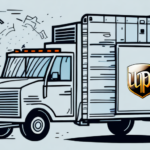Introduction to Liftgate Fees in Logistics
If you are involved in logistics or supply chain management, you have probably encountered the term liftgate fee. This additional shipping charge can significantly impact your supply chain costs, making it essential to understand its origins, types, costs, and overall effect on your operations. This article provides an in-depth analysis of liftgate fees, offering practical insights and strategies for managing them effectively.
Understanding Liftgate Fees
What is a Liftgate Fee?
A liftgate fee is a charge imposed by carriers for shipments that require the use of a hydraulic liftgate to load or unload freight. A liftgate is a device attached to the rear of a truck or trailer that elevates cargo from ground level to the truck bed. This service is typically necessary when the shipper or receiver lacks a loading dock or forklift, or when the freight is too heavy to be handled manually.
The liftgate fee covers the carrier's costs for providing and operating the liftgate, including the additional time and effort required to handle the shipment. Fees generally range from $50 to $150, depending on factors such as the carrier, the type of liftgate needed, and the shipment's weight and size. These fees are usually added to the shipping invoice and billed to the shipper or receiver.
The Evolution of Liftgate Fees
Liftgate fees became prevalent in the shipping industry during the 1990s. Prior to this, carriers often included liftgate service as part of their standard package delivery or truckload services without additional charges. However, the surge in e-commerce and home deliveries increased the number of shipments requiring liftgate service, leading carriers to introduce fees to cover the associated costs. Today, liftgate fees are a standard industry practice, integrated into most carriers' service contracts and tariffs.
For more details on the history and development of liftgate services, refer to the American Supply Association.
Types of Liftgate Fees
Standard Liftgate Fee
The basic fee for using a liftgate for commercial pickups or deliveries at locations equipped with a loading dock or forklift. This applies to shipments that necessitate a liftgate due to weight, size, or handling requirements.
Residential Liftgate Fee
An additional charge for using a liftgate for deliveries or pickups at residential addresses, such as private homes or apartment complexes. Residential liftgate fees are higher than standard fees, reflecting the increased time and difficulty of navigating residential areas and accessing front doors or garages.
Inside Delivery Fee
A fee charged for delivering freight inside a building or to a specific location within a building, such as a room or floor. This fee is often combined with a liftgate fee, especially for residential deliveries or commercial locations without loading docks.
Limited Access Fee
A charge for delivering or picking up freight at locations with restricted access, such as military bases, airports, construction sites, or hotels. This fee accounts for the extra paperwork, security checks, and coordination required to enter and exit these locations.
Costs and Pricing of Liftgate Fees
The cost of liftgate fees varies widely based on the carrier, service type, and region. Generally, you can expect to pay:
- $50 to $150 for standard or residential liftgate fees
- $50 to $100 for inside delivery fees
- $75 to $150 or more for limited access fees
According to industry reports from the Council of American Transportation Management, negotiating and comparing liftgate fees among different carriers is crucial, especially for businesses with high shipment volumes or complex supply chains. Some carriers may offer discounts or fee waivers for specific shipment types or customers, while others maintain strict surcharge policies.
When calculating the total cost of freight transportation, it's essential to factor in liftgate fees alongside other charges like fuel surcharges and transit times.
The Impact of Liftgate Fees on Businesses
Advantages of Liftgate Fees
- Cost Recovery: Liftgate fees help carriers cover the expenses associated with providing and maintaining liftgate equipment.
- Service Reliability: By charging for liftgate services, carriers can ensure they offer reliable and quality service to customers who need it.
- Pricing Transparency: Liftgate fees provide clarity in freight transportation costs, allowing businesses to budget and plan more effectively.
Disadvantages of Liftgate Fees
- Cost Variability: Liftgate fees can fluctuate based on the carrier, location, and shipment specifics, making it challenging for businesses to predict and control shipping costs.
- Operational Complexity: Managing liftgate services adds layers of coordination between shippers, carriers, and receivers, potentially leading to delays and increased risk of damage or injury.
- Customer Satisfaction: Unexpected or high liftgate fees can lead to customer dissatisfaction and cancellations, impacting business reputation and profitability.
Managing and Mitigating Liftgate Fees
Strategies to Reduce Liftgate Costs
- Consolidate Shipments: Combining multiple smaller shipments into larger ones can decrease the frequency of liftgate usage, thereby reducing overall liftgate fees.
- Negotiate with Carriers: Leverage your shipping volume to negotiate better rates and terms with carriers, potentially securing volume discounts or flat-rate pricing.
- Optimize Packaging and Handling: Efficient packing and loading techniques can minimize the need for liftgate services by making shipments easier to handle manually.
- Partner with Third-Party Logistics Providers (3PLs): Outsourcing logistics to 3PLs can provide access to their expertise and networks, helping to negotiate lower liftgate fees and manage the service more effectively.
Best Practices for Managing Liftgate Fees
- Clear Communication: Provide accurate shipment and location details to carriers to ensure they can prepare for liftgate services, reducing the likelihood of unexpected fees.
- Advance Planning: Schedule deliveries and pickups well in advance to allow carriers sufficient time to coordinate liftgate services efficiently.
- Track and Analyze Fees: Maintain records of all liftgate fees and regularly analyze them to identify patterns and opportunities for cost savings.
- Staff Training: Educate your team on liftgate fee policies and safe handling practices to minimize errors and improve overall logistics efficiency.
Future Trends in Liftgate Fees
The logistics industry is continuously evolving, and liftgate fees are expected to follow suit. Future trends and predictions include:
- Automation and Robotics: Advances in technology may lead to more automated liftgate services, reducing reliance on manual labor and potentially lowering fees.
- Sustainability Initiatives: Growing environmental concerns may drive the adoption of greener logistics practices, such as electric liftgates, which could influence pricing models.
- Enhanced Customer Expectations: As e-commerce grows, customer demand for flexible and convenient delivery options, including reliable liftgate services, will increase, pushing carriers to optimize their offerings and pricing transparency.
Case Studies: The Business Impact of Liftgate Fees
Manufacturer of Heavy Machinery
A manufacturer shipping heavy machinery nationwide incurs an average liftgate fee of $100 per shipment due to the size and weight of its products. With increasing shipment volumes, liftgate fees account for approximately 10% of total transportation costs. To mitigate these fees, the manufacturer negotiated discounted rates with multiple carriers, consolidated shipments to reduce liftgate usage frequency, and invested in training and equipment to enhance loading and unloading efficiency.
Furniture and Home Appliance Retailer
A retailer offering home delivery faces high residential liftgate fees of $150 per shipment, leading to customer dissatisfaction and order cancellations. To address this, the retailer partnered with a specialized 3PL that provided access to carriers with lower liftgate fees. This partnership streamlined logistics operations, reduced handling costs, and improved customer satisfaction by offering more competitive delivery pricing.
Conclusion: Optimizing Your Supply Chain with Liftgate Fee Management
Liftgate fees are a critical aspect of logistics management that can significantly influence your supply chain costs and customer satisfaction. By understanding the various types of liftgate fees, their associated costs, and their impact on your business, you can adopt effective strategies to manage and mitigate these expenses. Key actions include negotiating favorable rates with carriers, consolidating shipments, optimizing freight packing and handling, partnering with 3PLs or freight brokers, and diligently tracking and analyzing liftgate fees. Implementing these best practices will help you achieve a more efficient, cost-effective, and competitive logistics operation.






















